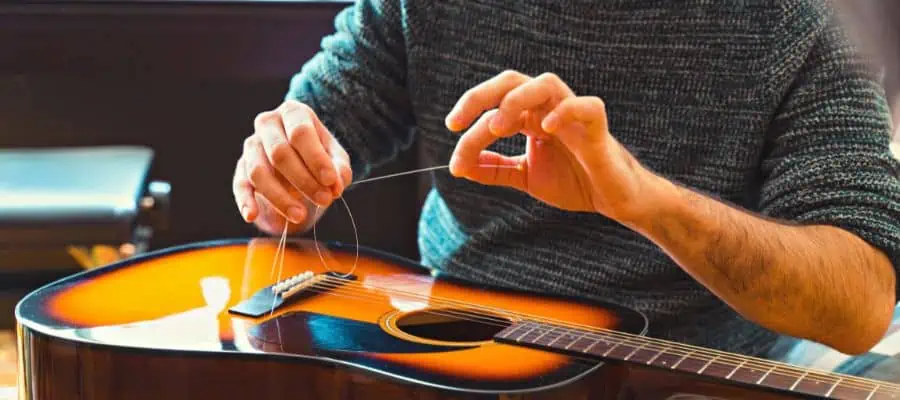Playing guitar with a missing string can be limiting, but it allows you to change your approach to the instrument. This can be pretty beneficial, forcing you to leave your comfort zone and create a different style.
Playing the guitar without the high E string might be unconventional, but it is certainly possible. The high E string, being the thinnest, is prone to breaking, and its absence can lead to a unique opportunity to explore your instrument in a different light.
Without the high E string, you’re encouraged to focus on the middle and lower ranges of the guitar, which can help develop a stronger rhythmic sense and reliance on the bass notes. This constraint could also serve as a springboard for creativity, nudging you to discover new chord voicings and picking patterns. It also presents a challenge that can improve finger strength and control over the remaining strings.
Such limitations could introduce a fresh perspective on songwriting and arrangement for guitarists looking to break away from traditional methods.
Rethinking Guitar Tuning

Playing the guitar without the high E string invites a fresh approach to tuning. When the uppermost string is missing, you’re challenged to explore alternate tunings and rethink chord shapes and scales. This can lead to new sounds and inspire creativity in your playing.
Alternate Tuning Configurations
Without the high E string, the standard EADGBE tuning isn’t complete. Here are some alternate configurations you might consider:
- Open Tunings: Common in blues and slide guitar, open tunings allow you to play a chord without fretting any strings. For example, Open D (DADF#AD) or Open G (DGDGBD), which normally uses the high E, can be adapted to exclude it.
- Drop Tunings: Often used in rock and metal, drop tunings lower the pitch of one or more strings. Drop D (DADGBE) can easily be used without the high E string.
- Standard Tuning Minus High E: Simply use standard tuning, but ignore the high E string. This challenges you to adjust chords and scales accordingly.
Adapting Chord Shapes and Scales
With the high E string gone, here are ways to adapt your playing:
- Chord Shapes: Many basic chords require the high E string. However, you can modify these shapes to avoid it. For example, just play the notes on the A, D, and B strings for an open C major chord.
- Scales: You can still play scales but must skip the high E string. For a pentatonic scale, use the B string as the highest note instead.
- Triads: Triads are the roots of the chords, as each chord is built with three notes. Learning the triad chord shapes can give you the freedom to play chords, as well as licks, on any three neighboring strings you choose. So, even without the high E string, you can play whatever you want.
Playing without the high E string may initially feel limiting, but it pushes you to be inventive and discover different musical possibilities.
Playing Techniques and Limitations

Sometimes, you might find yourself with a missing high E string on your guitar. While it’s not ideal, you can still play the instrument, albeit with some adjustments to your technique and understanding of the inherent limitations. Here’s what you need to know to make the most of the situation.
Fingerpicking Adjustments
When fingerpicking without the high E string, your approach must shift towards exploiting the other strings. Typically, you use the high E for melodies or to add brightness to a chord. Instead, focus on the B string for those upper register notes.
Rearrange the melody to fit the available strings, or transpose parts an octave lower if necessary. You’ll be surprised at the richness other strings can provide, even without their thinnest companion.
Strumming and Rhythm Challenges
For strumming and rhythm guitar work, the absence of the high E string requires some creativity. You must omit the high E string sounds from chords or replace those notes by playing them on another string. This can mean a fuller sound for some chords and a more muted effect for others. Be mindful of your strumming patterns and focus on the middle and lower strings to maintain the rhythmic drive of your playing without the high-end sparkle.
Conclusion
Absolutely, you can play guitar even if the high E string is not available. It’s a chance to explore alternate song options and unique playing techniques that don’t require that string. For instance, songs like Oasis’s “Wonderwall” and Pink Floyd’s “Wish You Were Here” can be performed without the high E. Moreover, the absence of the high E string can serve as motivation to cultivate creativity within your playing style, pushing you to discover novel chord voicings and perhaps even encourage a foray into songwriting.
Adaptability is a guitarist’s virtue. You can still practice many riffs, licks, and chords without the high E string. Alternative tunings such as Drop D are worth experimenting with, simplifying power chord shapes and injecting a different sonic characteristic into your playing. Or you can learn the triads to build chords in different positions.
You’ll be ready to continue playing seamlessly if a string breaks during a performance. Overall, the missing high E string exemplifies a minor hurdle, one that, with a bit of ingenuity and adaptability, you’ll overcome with ease. Keep playing, and let this be an opportunity to grow as a musician.
If you found this article useful, you may want to save this pin below to your Guitar board.

Recent Posts
Some guitarists insist on buying an expensive amplifier with their electric guitar. They assume that this is a must for every type of guitarist out there. However, in some situations, this isn’t...
Top 50 Free Realistic Guitar VST Plugins With Sound Examples
As technology has rapidly advanced in the recent decade, computers are stealing more and more roles from physical musical instruments and accessories. Nowadays, you do not need expensive amps,...

